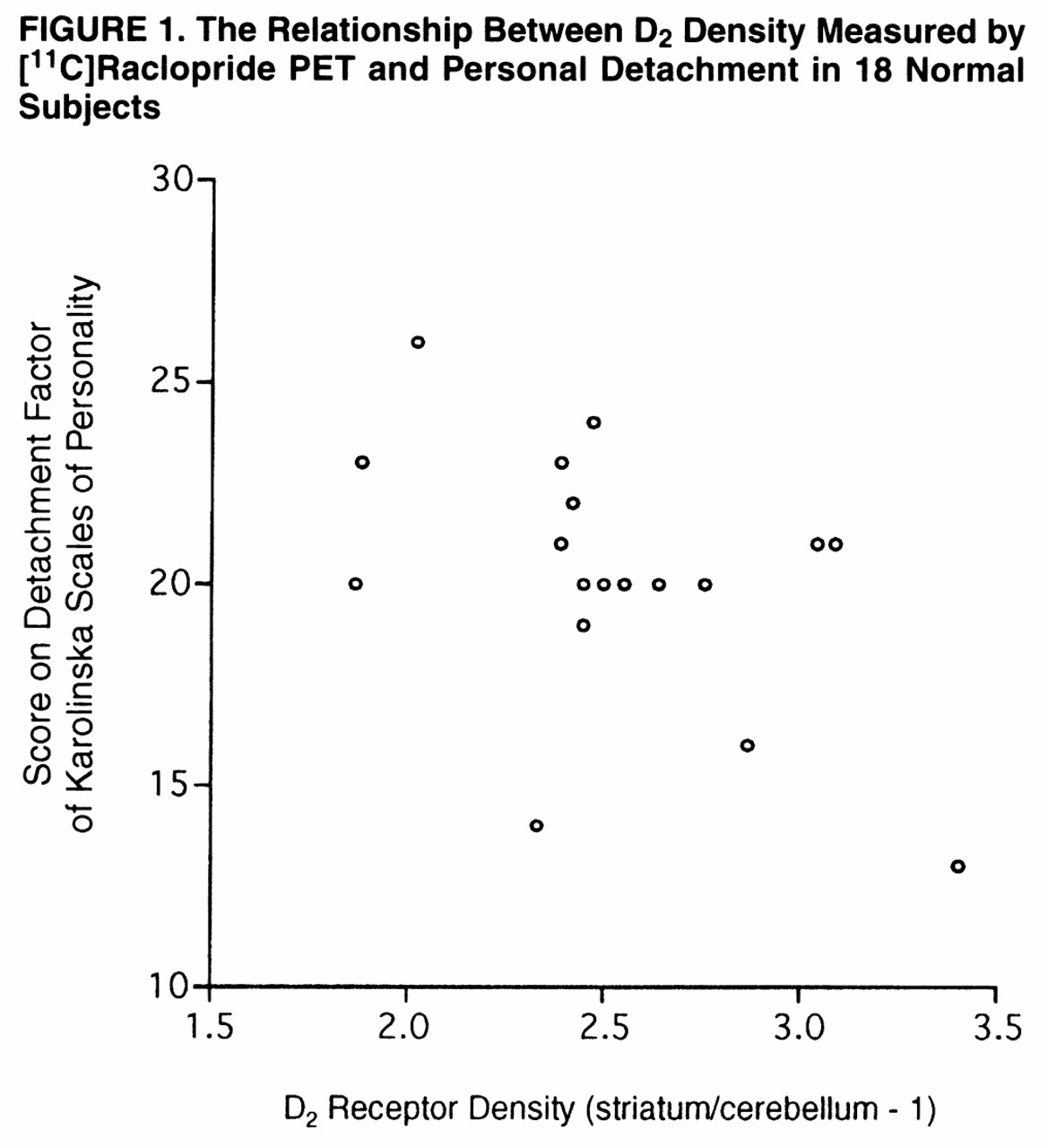Several lines of preclinical
(1) and clinical
(2) evidence implicate dopamine in a personality trait that involves personal detachment and aloofness. Recently, using [
11C]raclopride positron emission tomography (PET) and the Karolinska Scales of Personality
(3), Farde and associates
(4) reported a significant relationship between D
2 receptor density and detachment in 24 normal adult subjects. The purpose of our current study is to attempt to replicate the finding of Farde et al. and extend this work by 1) determining its generalizability to other measures of detachment and 2) determining its specificity by examining the relationship between D
2 specific binding and other personality traits. To accomplish these aims, we examined the relationship between striatal D
2 binding, as determined by [
11C]raclopride PET, and two measures of detachment: the Karolinska Scales of Personality detachment scores and the attachment scores from the Tridimensional Personality Questionnaire
(5). The primary hypothesis to be tested was that [
11C]raclopride specific D
2 binding is significantly associated with personal detachment as assessed by the Karolinska Scales of Personality and the Tridimensional Personality Questionnaire. Using exploratory analyses, we examined the relationship between specific D
2 binding and the other personality traits from the Karolinska Scales of Personality and the Tridimensional Personality Questionnaire.
METHOD
Eighteen subjects (mean age=33.1 years, SD=7.3; 14 men and four women) were recruited from the National Institutes of Health healthy volunteer office and participated in the study after giving written informed consent to a protocol approved by our institutional review board. Subjects had no current or past history of psychiatric illness, including polysubstance abuse and alcohol dependence, as determined by a structured diagnostic interview
(6). They were in good physical health as determined by a physical examination, ECG, and screening blood work.
Each subject completed the Karolinska Scales of Personality and the Tridimensional Personality Questionnaire. The Karolinska Scales of Personality comprise 15 subscales, and each item is scored from 1 (does not apply at all) to 4 (applies completely). The Karolinska Scales of Personality detachment cluster comprises 10 individual items, and a high score reflects more detachment. The Tridimensional Personality Questionnaire comprises several individual clusters, and each Tridimensional Personality Questionnaire item is scored true or false. The attachment cluster has 11 items and, contrary to the Karolinska Scales of Personality, high scores reflect less detachment.
Each subject participated in a [
11C]raclopride PET study. The scanning protocol has been described previously
(7). Briefly, [
11C]raclopride (2–8 mCi) was administered as a constant bolus infusion
(8). Data from five consecutive scans between 30 and 50 minutes following the bolus, which reflected tracer equilibrium, were used in the analyses. Volumes of interest were drawn in the cerebellum and left and right striatum (encompassing the caudate and putamen) on summed images
(8). The specific binding was computed as striatum/cerebellum–1.
Striatal [
11C]raclopride binding was related to Karolinska Scales of Personality detachment and Tridimensional Personality Questionnaire attachment scores by using Pearson’s correlation coefficient. Since sex, race, and age are known to affect personality trait data, a secondary analysis was conducted to adjust for the possible effects of sex and age on the Karolinska Scales of Personality and sex and race on the Tridimensional Personality Questionnaire after scores were transformed to T scores by using normative data
(4,
5). Exploratory analyses relating the other Karolinska Scales of Personality and Tridimensional Personality Questionnaire cluster scores and striatal binding were conducted with Pearson’s correlation coefficient.
RESULTS
The Karolinska Scales of Personality detachment scores were significantly related to striatal [
11C]raclopride binding (r=–0.50, df=16, p=0.03) (
figure 1). After T-score transformation to adjust for sex effects, the relationship remained significant (r=–0.49, df=16, p=0.04). However, the Tridimensional Personality Questionnaire attachment scores were not significantly related to striatal specific binding (r=0.23, df=16, p=0.34), and T-score-transformed data also were not significantly related to specific binding (r=0.25, df=16, p=0.27). The Karolinska Scales of Personality detachment scores and Tridimensional Personality Questionnaire attachment scores were significantly related to each other (r=–0.50, df=16, p=0.04). There were no significant relationships between specific binding and the other Karolinska Scales of Personality cluster scores (r=0.27 to –0.39, p>0.10), including the irritability cluster (r=–0.005, df=16, p=0.98). The Tridimensional Personality Questionnaire sentimentality score, which comprises five items, was significantly related to binding (r=–0.71, df=16, p=0.001). In addition, it was positively correlated with the Karolinska Scales of Personality detachment score (r=0.47, df=16, p=0.05). The other Tridimensional Personality Questionnaire cluster scores were not related to binding (r=0.31 to r=–0.29, p>0.20).
DISCUSSION
The results of this study indicate that Karolinska Scales of Personality detachment scores were significantly related to striatal [
11C]raclopride binding. These data replicate a recent report by Farde et al.
(4), who reported a significant relationship between Karolinska Scales of Personality detachment scores and striatal [
11C]raclopride binding in 24 normal adult subjects. Although there were striking methodological similarities between the studies (i.e., enrollment of normal subjects, use of the Karolinska Scales of Personality, and use of [
11C]raclopride PET), there were important differences as well, including the scanning method, placement of striatal volume of interest, and quantification of specific binding. Thus, this independent replication strongly supports the validity of the relationship between D
2 receptor density and the detachment personality trait as defined by the Karolinska Scales of Personality.
The failure to find a significant relationship between specific binding and Tridimensional Personality Questionnaire attachment scores suggests that the relationship between striatal D2 receptor density and this personality trait is complex. Even though the Karolinska Scales of Personality and Tridimensional Personality Questionnaire cluster scores were significantly correlated (p=0.04), the correlation coefficient of –0.50 indicates that only 25% of the variance is accounted for by both scales. Thus, each scale appears to capture independent aspects of personal detachment. In addition, there are metric differences between the scales, including scoring (1 to 4 for Karolinska Scales of Personality items versus true/false for Tridimensional Personality Questionnaire items) and the wording and content of individual factor items.
We found a significant negative relationship between striatal D2 binding and Tridimensional Personality Questionnaire sentimentality scores. Since these data were examined in exploratory analyses, we did not correct for multiple comparisons. Therefore, it will be important to replicate this finding to begin to ascertain its validity.
In conclusion, these findings add to a growing body of data implicating dopamine in personality traits. More research is needed to determine which aspects of personal detachment are most strongly associated with dopaminergic function and if disease states that resemble detachment, such as schizoid personality disorder and negative symptoms, have related dopaminergic pathophysiologies.


